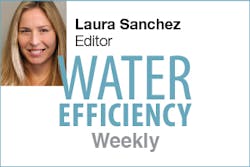Fixing Flint: A Case for Corrosion Control Plans
The science of corrosion is complex. It is a multi-faceted electrochemical reaction with a myriad of invisible variables. On a fundamental level, the process transfers ions from a metal to a solution, which results in both the deterioration of the metal and contamination of the solution.
The science of corrosion is complex. It is a multi-faceted electrochemical reaction with a myriad of invisible variables. On a fundamental level, the process transfers ions from a metal to a solution, which results in both the deterioration of the metal and contamination of the solution. [text_ad] Internal corrosion within lead distribution pipelines and home plumbing systems can cause significant health problems. Dissolved metals are especially toxic to children and unborn babies. While the obvious solution is to simply avoid lead pipes, they have been used in plumbing for centuries—the element’s chemical symbol is Pb a derivative of the Latin plumbum, or water works. Furthermore, the replacement of existing lead pipes is often cost prohibitive. Corrosion is controllable, however, through manipulating water chemistry and “passivity,” or creating a physical scale within pipes that traps metals and makes them unavailable for release into water. Most utilities treat surface water with phosphate corrosion inhibitors. They determine an optimal dosage and simply adjust the water chemistry. A corrosion control plan is critical. Changes in water quality and chemistry sometimes dissolve the mineral coatings within pipes, exposing them to corrosion as was the case in Flint, MI. High levels of chloride in untreated water from the Flint River began corroding the municipality’s distribution pipes, and consequentially contaminated the water supply. According to the Guardian, the corrosiveness level as measured by the Larson Iron Corrosion Index rose from “0.54 (low corrosion) to 2.3 (very high corrosion) and the chloride to sulfate mass ratio (CSMR) index for lead corrosion increased from 0.45 (low corrosion) to 1.6 (very high corrosion).” Water distribution managers are encouraged to follow major changes in their water supply with loop tests to assess the effectiveness of corrosion control strategies. Water suppliers typically have a choice of two types of testing used for assessing corrosion: flow-through testing and static testing. Flow-through tests effectively simulate the distribution system and home plumbing conditions but are time consuming and costly. Static testing or “no flow-through” testing measures the buildup of corrosion release products in the re-circulated water and can provide more rapid results. Under the Safe Drinking Water Act (SDWA), EPA requires that water suppliers perform regular analyses of their water. The agency has established standards for the presence of over 90 different contaminants in public drinking water, as well as maximum contaminant levels and treatment technique requirements for each one. It mandates that water suppliers provide the information to consumers in annual Consumer Confidence Reports (CCR). Compliance testing is typically conducted once a year, prior to the supplier’s CCR and consumers can view the CCR for their municipality on EPA’s website: www.epa.gov/ccr. Does your water system have a corrosion control plan in place? How often is your water tested?Internal corrosion within lead distribution pipelines and home plumbing systems can cause significant health problems. Dissolved metals are especially toxic to children and unborn babies. While the obvious solution is to simply avoid lead pipes, they have been used in plumbing for centuries—the element’s chemical symbol is Pb a derivative of the Latin plumbum, or water works. Furthermore, the replacement of existing lead pipes is often cost prohibitive.
Corrosion is controllable, however, through manipulating water chemistry and “passivity,” or creating a physical scale within pipes that traps metals and makes them unavailable for release into water. Most utilities treat surface water with phosphate corrosion inhibitors. They determine an optimal dosage and simply adjust the water chemistry. A corrosion control plan is critical.
Changes in water quality and chemistry sometimes dissolve the mineral coatings within pipes, exposing them to corrosion as was the case in Flint, MI. High levels of chloride in untreated water from the Flint River began corroding the municipality’s distribution pipes, and consequentially contaminated the water supply. According to the Guardian, the corrosiveness level as measured by the Larson Iron Corrosion Index rose from “0.54 (low corrosion) to 2.3 (very high corrosion) and the chloride to sulfate mass ratio (CSMR) index for lead corrosion increased from 0.45 (low corrosion) to 1.6 (very high corrosion).” Water distribution managers are encouraged to follow major changes in their water supply with loop tests to assess the effectiveness of corrosion control strategies.
Water suppliers typically have a choice of two types of testing used for assessing corrosion: flow-through testing and static testing. Flow-through tests effectively simulate the distribution system and home plumbing conditions but are time consuming and costly. Static testing or “no flow-through” testing measures the buildup of corrosion release products in the re-circulated water and can provide more rapid results.
Under the Safe Drinking Water Act (SDWA), EPA requires that water suppliers perform regular analyses of their water. The agency has established standards for the presence of over 90 different contaminants in public drinking water, as well as maximum contaminant levels and treatment technique requirements for each one. It mandates that water suppliers provide the information to consumers in annual Consumer Confidence Reports (CCR). Compliance testing is typically conducted once a year, prior to the supplier’s CCR and consumers can view the CCR for their municipality on EPA’s website: www.epa.gov/ccr.
Does your water system have a corrosion control plan in place? How often is your water tested?
